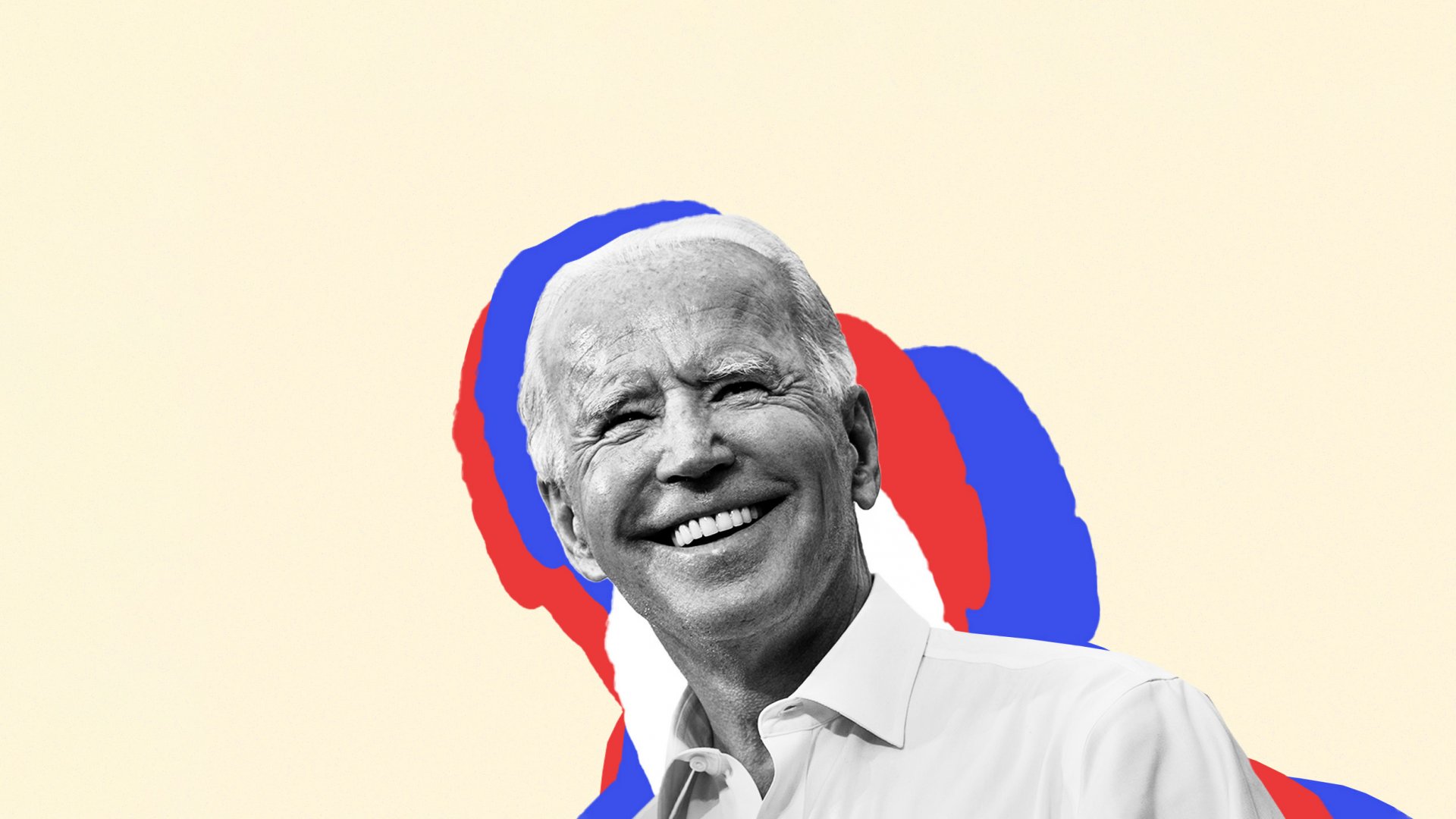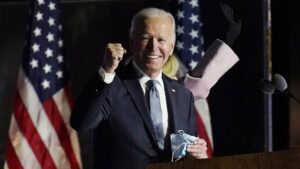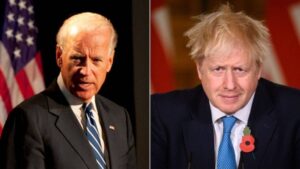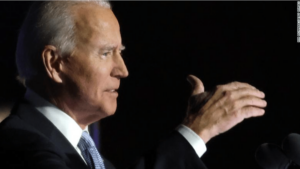The former vice president won the top job, but undoing Trump’s discordant legacy won’t be easy

Photo: Getty Images/Illustration: Chloe Krammel
After an election season like no other, Joe Biden is set to become the 46th President of the United States. While his victory signals a major shift in policy, he may be hard-pressed to undo Donald Trump’s legislative agenda, especially if the Senate majority remains Republican–something we might not know until January.
Even so, initiatives such as additional pandemic relief and potentially revising the Affordable Care Act are certainly within his grasp. Here’s what you can expect from a Biden White House:
Related Posts
Taxes
Many of the elements of Trump’s biggest legislative achievement–the Tax Cuts and Jobs Act (TCJA) of 2017–are set to expire in the next few years. To name two: the research and development tax credit, which in 2022 requires businesses to amortize expenses over five years rather than doing so immediately, as is the current case. And full expensing for short-term business investments will begin phasing out in 2023.
Many of these expiring provisions run contrary to what Biden is trying to accomplish, so there’s a good chance he’ll let them sunset, says Bill Smith, managing director for CBIZ MHM’s National Tax Office in Bethesda, Maryland. A good example, he notes, is the section 199A qualified business income deduction, which Biden wants to phase out for taxpayers with incomes over $400,000. That provision, oft referred to as the “pass-through deduction,” allows certain types of businesses to deduct up to 20 percent of their qualified business income–that is, money generated through the normal course of running an active business.
Of course, some tax cuts may be unpalatable to phase out. For instance, the increase in the standard deduction and the expanded child tax credit, which will revert to the prior law, but not until 2026.
Notably, Biden also favors rolling back several key aspects of the TCJA, including revising the corporate tax rate to 28 percent from 21 percent. Prior to the TCJA, the top corporate tax rate was 35 percent. And he’d reset the top individual bracket to 39.6 percent, from 37 percent, for those with incomes above $400,000. That could directly affect pass-through entities like limited liability companies and S Corps.
Apart from the TCJA, Biden has discussed establishing a “Made in America” tax credit of 10 percent on activities that could restore U.S. production, revive existing or closed facilities, or expand manufacturing jobs. The measure would be a counterpoint to a new 10 percent surtax on corporations that offshore manufacturing and service jobs–customer call centers, say–to foreign nations that then serve American consumers.
Small-Business Aid
The fact that millions of small businesses need additional help amid the ongoing pandemic is not lost on Biden, who throughout the campaign signaled his expectation for a continuation of bleak times. “You got one in six of them going under. They’re not going to be able to make it back,” said Biden at the final debate on October 22. Indeed, nearly 2 million–mostly small–American businesses have already closed in 2020, according to Oxxford Information Technology, an information services firm in Hagaman, N.Y., which tracks about 32 million businesses. And coronavirus cases continue to explode. The U.S. recently logged a single-day record number of coronavirus cases, at more than 100,000.
While Biden’s actual small-business aid program is dated, in more recent days he has expressed support for the Paycheck Protection Program, the $525 billion forgivable-loan program aimed at small businesses. He has also said he’d support a “restart package” that would help small businesses cover the cost of personal protective equipment and retrofitting an establishment to, say, install plexiglass. And to the extent that small businesses benefit when their customers are more willing to spend, Biden says he would favor enhanced student-loan forgiveness and unemployment benefits, along with another batch of stimulus checks for American families.
It’s important to note, however, that Biden doesn’t take office until January 20, 2021, and Congress could pass something before Trump’s term ends. In the election run-up, White House advisers and House Democrats tried to put together another stimulus package.
That’s not likely to happen, says Dean Baker, a senior economist at the nonpartisan Center for Economic and Policy Research in Washington, D.C. There’s less leverage to make a deal now that the election is over. And after Biden takes office, he’ll likely face continued resistance to stimulus efforts from Senate Republicans. “[Mitch] McConnell (R-KY) opened the Senate back in 2009, saying that his job was to make sure [Barack] Obama was a one-term president,” says Baker. “I’m sure that would be his view again.” Indeed, McConnell recently noted that a deal wouldn’t come until “next year.”
It is possible, however, that lawmakers will convene on more narrow, bipartisan measures, like supplementing unemployment insurance or tweaking the PPP, so that only the hardest-hit businesses may get a second shot at the program. Trump himself has shown interest in this path.
Health Care
With the confirmation of Amy Coney Barrett to the Supreme Court, the question of what will happen to the Affordable Care Act (ACA), or Obamacare, comes into focus. On November 10–just days after the election–the justices will consider the constitutionality of the landmark health care law in the absence of the individual mandate. Trump’s 2017 tax law eliminated the ACA’s penalty for not having health insurance–a technical change that voided the individual mandate.
With six conservative judges now pinned against three progressive jurists, there’s a very real chance the ACA could meet its end. That will carry downstream consequences for small businesses, says Robert Litan, an economist and nonresident senior fellow at the Brookings Institution, a nonpartisan think tank in Washington. He warns that nullifying the law could trigger “chaos in the insurance markets” and that instability could hit employers of all stripes.
While we won’t have a decision until next summer, there’s a chance that the justices won’t strike down the full law. “Despite all the furor over the ACA case during the Barrett confirmation hearings, I still suspect they’ll sever that one piece and not strike down the law,” Litan tells.
Beyond the ACA, Biden has proposed tamping down on prescription drug prices and expanding the eligibility age for Medicare, to age 60 from 65. He further proposed a government-administered insurance program, or a “public option,” to compete with private insurers. The public option would be offered, premium-free, to Americans who live in states that don’t have access to Medicaid benefits. The states that currently support the federal programs could choose the public option, too, but they’d still be expected to pay their current share of the cost of covering those individuals.
Of course, most if not all of these ideas could get challenged in Congress if Republicans maintain control in the Senate. As a proxy for what’s to come, it can be helpful to review what took place during Barack Obama’s second term. At the time, the House was led by Republicans, who voted to repeal Obamacare more than 60 times. At one point, the measure garnered enough votes to reach Obama’s desk, where he vetoed it. If nothing else, you can expect that Biden will follow suit.
Jobs
Biden wants to boost the federal minimum wage to $15, from $7.25 currently. Business advocates have long warned–although the data is inconclusive–that a minimum wage hike will hurt small businesses’ ability to hire or maintain staffing levels. (In the states and municipalities that have local minimum wage laws, hourly minimums range from $5.15 to $15 an hour.) And his plans to raise taxes on corporations and high-income earners, which could affect those with pass-through entities such as limited liability corporations and S Corps, may also deter hiring. As the standard logic goes, if owners have less to spend, they could pull back on growth and thereby throttle jobs.
As for whether the Trump tax law performed as intended, it’s hard to judge, says Erica York, an economist at the Tax Foundation, a conservative think tank in Washington, D.C. The full accounting of the law–which created incentives for business owners to put their previously taxable dollars to work by way of investments in new facilities and/or products or services–will take years to come into view. “We do know that the vast majority of taxpayers saw a tax cut, across income groups–from the lowest quintile to highest quintile,” she says. “And of course we’ve seen a number of other disruptions since that law was put into place. The trade war, increased tariffs, the global pandemic, and the recession that ensued all work in the opposite direction of the tax cuts.”
Some analysts argue that the TCJA’s tax provisions lowered the cost of capital and significantly increased business investment, according to a 2019 report from the Council of Economic Advisors. Others say businesses have deployed only a small portion of the cash freed up by the TCJA for investments.
It’s also hard to pinpoint what exactly triggered the nation’s low unemployment rate, which fell to 3.5 percent at the end of 2019. Regardless of past economic drivers, Biden will have his work cut out for him. Five million more people were unemployed in September than in January of 2017 when Trump took office.
Biden might just succeed, however, says Litan, pointing to his green infrastructure plan, which would put around $2 trillion into retrofitting the country’s infrastructure and energy systems. “He wants to turn the economy green,” says Litan, who adds that the U.S. would see more than just construction jobs. “You get a ripple effect” across other industries like restaurants and entertainment, he says.
Specifically, Biden aims to create a zero-emissions energy sector by 2035. He is also looking to weatherize millions of homes and upgrade 4 million buildings to boost energy efficiency. The plan further calls for shifting major cities more toward public transportation.
Of course, getting congressional approval for an infrastructure project of this magnitude will be challenging. Consider Trump’s own long-promised infrastructure plan, which he hinted at on the campaign trail in 2016 but didn’t announce formally until 2018. At the time, he called for a public-private partnership that would leverage $200 billion in federal spending into $1.5 trillion for infrastructure projects. The proposal was met with skepticism across Congress and has since stalled. If Congress remains divided, Biden’s own plan would likely be met with similar resistance.
Trade
Under Trump, the U.S. imposed nearly $80 billion in tariffs, marking “one of the largest tax increases in recent history,” says York, who notes, too, that the effort sparked retaliatory tariffs from China, and other nations. As a result, businesses may face higher costs, both when they import goods but also when they export. “We’ve estimated that that has a negative long-run effect on output, on wages, [and] on the number of jobs that are in the U.S. That really works in opposition to the tax cuts that Trump signed into law.”
Biden would most likely reduce or void most of the Trump tariffs, says Baker. “Some of the tariffs have basically no purpose; Trump was picking a trade war with Canada. What that accomplishes, I have no idea,” he says. Baker expects Biden could also approve a bilateral trade deal with the U.K. once that nation fully exits the European Union. Litan agrees that a Biden presidency would look to unite frayed ties with Europe. “They’re going to try and put Humpty back together again,” he says.
But he doesn’t think Biden will ease up on China. “If Biden is president, he will try to restore good relations with allies–Canada and Europe–and will try to present a more united western world front against China.”
At the final presidential debate, Biden hinted as much. He noted that he’d attempt to have the world’s most populous country “play by the international rules.” He also said that he’d look to reform China’s foreign direct investment rules, which now require U.S. businesses operating in China to form a joint venture with a Chinese company and take a minority position in the venture. “We would not do that at all, No. 1,” said Biden.
Immigration
Under Trump, it has been open season on immigrants–from those attempting to cross the border illegally to those applying for refugee status to foreign university students looking to study here.
Trump’s sweeping changes to H-1B visas, the nation’s high-skilled guest-worker program, were deemed a major departure from recent administrations. On October 6, the White House announced a series of rule changes that stand to make hiring foreign workers more difficult and more expensive for U.S. employers.
Still, it isn’t clear Biden disapproves of the H-1B visa program reforms. Indeed, as president, he might go even further. “I think he’d look to improve conditions for people coming on H-1Bs,” says Baker. For instance, Biden could ease job mobility for H-1B workers who switch jobs. Currently, the new employer is required to file a new visa application, which can take months and may not get approved.
At the very least, you can expect that Biden will uphold the executive orders relating to immigration that President Obama pushed through. That includes the Deferred Action for Childhood Arrival program, or DACA, which allows a small population of undocumented people to legally work for American companies. Baker points out that Biden could even open the door to providing a “clear path to citizenship” for these people. But depending on the makeup of Congress, that might just need to wait until his second term, should he get one.
INC / Balkantimes.press
Napomena o autorskim pravima: Dozvoljeno preuzimanje sadržaja isključivo uz navođenje linka prema stranici našeg portala sa koje je sadržaj preuzet. Stavovi izraženi u ovom tekstu autorovi su i ne odražavaju nužno uredničku politiku The Balkantimes Press.
Copyright Notice: It is allowed to download the content only by providing a link to the page of our portal from which the content was downloaded. The views expressed in this text are those of the authors and do not necessarily reflect the editorial policies of The Balkantimes Press.



